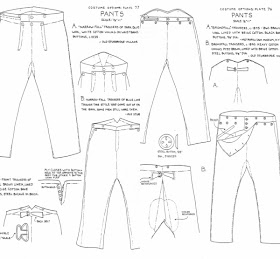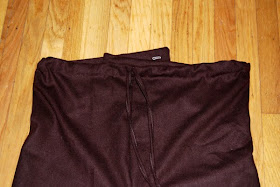A friend mentioned that her son needed historically accurate trousers for his overnight
ELP at Sutter's Fort. Because I'd made a pair for my older son when he participated in the same program 7 years ago, I offered to help. It's the kind of project I like: unusual, only partially defined, and where a willingness to dive in and improvise matters more than precision or skill.
This is what we had to go on. It's a couple of pages from the very detailed costume book that Sutter's Fort provides ELP participants.
I had also spent a day with a historical re-enactor in 2002 and remembered her comments about period clothing--specifically, that pants were not tailored the way they are today so had saggy bottoms or at best, a loose-fitting gusset between the legs. Zippers were yet to be invented: flies were held together with buttons, and pants were usually held up with suspenders or a buckle in the rear which could tighten at the waist (all seen in the details of the above images).
We did not use a pattern, but measured waist and leg length, and cut with plenty of room for error.
Cathy had a yard or so of beautiful brown wool. From this we cut four leg pieces (front/back & left/right), which she sewed together. She had not sewn with a machine before but possessed an innate deftness that impressed me. The things we learn about our friends, even after years of knowing them!
After the legs were made, we needed front straps to pull the waist together and to fasten the fly to (see image in lower right corner of Sutter's Fort costume illustrations, above). We cut a newspaper pattern to test it first and to be sure the pieces were the same size. There were four pieces in all, sewn right sides together and turned.

At this point we began to bear down and focus, as time was an issue. The trousers were to be worn for the first time two days after we began making them. We had afternoon hours only, so were in a bit of a crunch.
Waist straps were attached to the top of the rear leg pieces, while the top of the front leg pieces were shaped into a fly flap. We added a diamond-shaped gusset. Now the trousers looked like this:

If you're thinking they look a little wide for a 10-year-old boy, you are much more observant than I was. They were, in fact, huge.
But the beauty of sewing by the seat of one's pants is that fixing is built into the process. Here is Cathy trimming excess fabric after having sewn a new seam a couple inches in.
We also had to rip out and redo the gusset, and then the trousers began to look more like what we had in mind.
Buttonholes were made on the machine, not by hand. But had there been time,
handmade buttonholes would have been very nice.
To shape the waist, we simply added a casing and put a drawstring in the back. Again, this was a matter of time and getting them to a wearable state as quickly as possible.
I'd like to be able to tell you that this was a beautiful homeschooling moment, and that our boys (Cathy's two and my younger) were eagerly cutting and sewing alongside us. But in fact, they were running around outside using each other as targets.
They only reluctantly came in for the necessary fittings, then ran outside again.
I still call this a great homeschooling day. Because even in all that running around, I know they were at least vaguely aware of the fact that we were creating something, solving a problem piece by piece and hour by hour. And although my kids no longer think it's cool, they both have experience sewing--which is really just another way of constructing something from nothing. In years past we have made quilts and clothing, toys and costumes together. They started by drawing their ideas on paper, thought about how they would put it together, and finally, stitched--first by hand, and later, with the machine.
Unschooling can only work when we aren't invested in having our children acquire a specific body of knowledge. If my kids leave home without the ability to do higher math, without having read The Deerslayer, without playing the piano or speaking French…so be it. What I want for them is more abstract: to be able to meet the situations and challenges in their lives, know they can handle them, and hopefully, enjoy the process along the way. That's nothing I can teach, per se--it's an acquired attitude, one which comes piece by piece and hour by hour, as one continues to do things by the seat of one's pants and realize that it all works out just fine.























